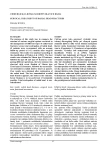The time distribution of the incidence of the most frequent injuries to the musculoskeletal system
Authors:
Josef Tislický 1; Peter Škapinec 1; Valér Džupa 2; Bohumír Procházka 3
Authors‘ workplace:
rd Faculty of Medicine, Charles University, Prague
1; 3. lékařská fakulta Univerzity Karlovy, Praha
1; Orthopaedic Department, rd Faculty of Medicine, Charles University, and University Hospital
Kralovske Vinohrady, Prague
2; Ortopedicko-traumatologická klinika 3. LF UK a FNKV, Praha
2; Center of Preventive Medicine, 3rd Faculty of Medicine, Charles University, and National Institute
of Public Health, Prague
3; Centrum preventivního lékařství 3. LF UK a Státní zdravotní ústav, Praha
3
Published in:
Úraz chir. 14., 2006, č.2
Overview
The authors examined the time distribution of the incidence of individual types of injury to the musculoskeletal system (open wound, contusion, fracture,distorsion, dislocation, injury to tendons) in the course of the day and the trauma – treatment interval in the case of these injuries. They focused on fractures of the proximal humerus, the distal radius, the proximal femur and the ankle. The group followedup comprised 2362 patients (1142 women, 1220 men) older than 15 years who were treated between 1 January and 31 March 2004 for primary injury to the musculoskeletal system at the Orthopaedic Department of 3rd Faculty of Medicine of Charles University in Prague. The group was followedup prospectively. The authors recorded the patient´s age, gender, diagnosis, the time of injury and trauma – treatment interval.
Conclusions:
The study revealed that open wounds, contusions and fractures were almost equally distributed throughout the day. The time distribution of the incidence of distorsions, dislocations and injuries to tendon was unequal, with an insignificant prevalence of the incidence of these injuries in the afternoon and evening hours. A significant difference was recorded in the comparison of open wounds and fractures at night and during the day (p= 0,001) and distorsions and fractures also at night and during the day (p< 0,001). The trauma –treatment interval was significantly shorter in bleeding wounds as compared to other types of injuries (p< 0,001).
The trauma – treatment interval in case of fractures of the proximal humerus, the distal radius, the proximal femur and the ankle showed no significant differences.
Key words:
musculoskeletal injuries, time distribution, traumatreatment interval.
Sources
1. Aharonoff, G.B., Dennis, M.G., Elshinawy, A. et al. Circumstances of falls causing hip fractures in the elderly. Clin Orthop. 1998, 348,10–14.
2. Bosch, U., Schreiber, T., Krettek, C. Reduction and fixation of displaced intracapsular fractures of the proximal femur. Clin Orthop. 2002, 399, s. 59–71.
3. Cuenca, J., Martínez, A.A., Herrera, A., Domingo, J. The incidence of distal forearm fractures in Zaragoza (Spain). Chir Main. 2003, 22,s. 211–215.
4. Dorotka, R., Schoechtner, H., Buchinger, W. The influence of immediate surgical treatment of proximal femoral fractures on mortality and quality of life. Operation within six hours of the fracture versus later than six hours. J Bone Joint Surg. 2003, 85B, s. 1107–1113.
5. Eľko, M., Mrug, L.: Ako ďalej v liečbe Achillovej šľachy? Úraz chir. 2000, 8, s. 37–41.
6. Hart, R., Janeček, M., Buček, P., Zelníček, P. Operační léčba přetržené Achillovy šlachy. Acta Chir orthop Traum čech . 2000, 67, s. 415–418.
7. Healy, W.L., Iorio, R. Total hip arthroplasty. Optimal treatment for displaced femoral neck fractures in elderly patients. Clin Orthop. 2004, 429,s. 43–48.
8. Hertel, R. Fractures of the proximal humerus in osteoporotic bone. Osteoporos Int. 16 (Suppl 2), 2005, s. S65–S72.
9. Hudson, J.I., Kenzora, J.E., Hebel, J.R. et al. Eightyear outcome associated with clinical options in the management of femoral neck fractures. Clin Orthop. 1998, 348,s. 59–66.
10. Chung, K.C., Spilson, S.V. The frequency and epidemiology of hand and forearm fractures in the United States. J Hand Surg. 2001, 26A, s. 908–915.
11. Jarnlo, G.B., Thorngren, K.G. Backround factors to hip fractures. Clin Orthop. 1993, 287, s. 41–49.
12. Josten, C., Tiemann, A.H. Komplikationen nach proximalen Femurfrakturen. OPJournal. 2002, 17,s. 148–153.
13. Kettunen, J., Kröger, H. Surgical treatment of ankle and foot fractures in the elderly. Osteoporos Int. 16 (Suppl 2), 2005, s. S103–S106.
14. Koval, K.J., Zuckerman, J.D. Hip fractures: I. Overview and evaluation and treatment of femoralneck fractures. J Am Acad Orthop Surg. 1994, 2, s. 141–149.
15. Raaymakers, E.L.F.B. Fractures of the femoral neck: A review and personal statement. Acta Chir orthop Traum čech. 2006, 73, s. 45–59.
16. Ring, D., Jupiter, J.B. Treatment of osteoporotic distal radius fractures. Osteoporos Int. 16 (Suppl 2), 2005, s. S80–S84.
17. Škapinec, P., Tislický, J., Džupa, V., Procházka, B. Přehled úrazových diagnóz pacientů ošetřených na traumatologické ambulanci v zimních měsících. Osteol Bull. 2005, 10, s. 27–32.
18. Teasdall, R.D., Webb, L.X. Innovations in the management of the hip fractures. Orthopaedics. 2003, 26, s. 843–849.
19. Trč, T., Pacovský, V. Perkutánní sutura Achilovy šlachy: předběžné sdělení a první zkušenosti. Acta Chir orthop Traum čech. 1996, 63, s. 208–210.
20. Zuckerman, J.D., Schon, L.C. Hip fractures. In: Zuckerman, J.D. Comprehensive care of orthopaedic injuries in the elderly. BaltimoreMunich: Urban&Schwarzenberg 1990. 23111.
Labels
Surgery Traumatology Trauma surgeryArticle was published in
Trauma Surgery

2006 Issue 2
Most read in this issue
- SURGICAL TREATMENT OF RADIAL HEAD FRACTURES
- Our experiences with mosaicplasty of the injured knee
- COMPARTMENT SYNDROM AND THE INJURIES OF THE TIBIA
- Proximal femur fractures treated with the nail Targon PF – our first experiences
